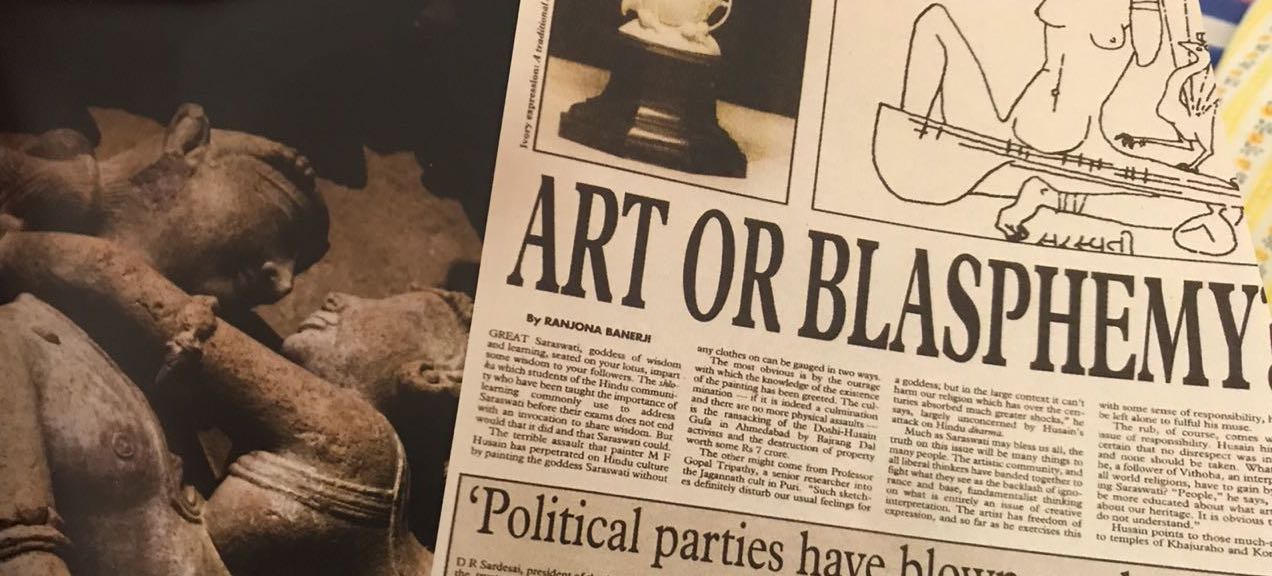With #Defenddissent trending on Twitter for parts of this week, ideas of a collective pushback for freedom of expression were swirling around the Internet.
As usual, Twitter led me down a rabbit hole of introspection – who are we looking at to defend dissent, who are we looking at to create it and is it really that important?
On June 20th, Marg – a quarterly Indian art magazine – published its latest copy which primarily dealt with the themes of freedom of and after speech, cultivating creative areas of dissent and the rising forces of intolerance.

Magazine cover for MARG
Credit: Devina Buckshee
To promote the magazine, there was a panel discussion event with panellists Ram Rahman, the founding member of SAHMAT, journalist and documentary filmmaker Paranjoy Guha Thakurta, and artist Amar Kanwar in a discussion with editor Latika Gupta on the role of art in activism.
Almost immediately, the socio-political climate of silencing and stifling of dissent and creativity were spoken on. “The rise of communalism and increasing restrictions of freedom of expression are intertwined,” said Kanwar.
Thakurta added, “The levels of intolerance have increased and grown to critical levels. It’s almost comparable to the limits during the emergency.”
The art world is made up of many perspectives and many people – writers, painters, scholars, poets, architects, photographers, designers, cultural activists, media people and free thinkers. They are the often at the forefront of socio-politics, probing, dissecting and interacting with the world around them.
For me, the most interesting pieces of work are ones that reveal a new perspective and start conversations. This is best done when art engages with the current happenings and helps break down complex concepts like the ideology, philosophy and morality of what’s going on in the world. This often means art veers into political territory, albeit obliquely.
Art is an important factor in increasing critical thinking and can influence public thought, encouraging people to partake in discussions on social matters – eventually creating the space for social reform.
Making art political, pushing the boundaries and taking risks is essential in fighting demanding for a real and operational democracy. Of course, this would mean a coming together of the diverse art community to support and stand in solidarity with anyone caught in the (often violent) crosshairs of intolerant mobs.
The purpose of art
One of the enduring questions of art as a whole is to question who it’s really for. The creator themselves? Or the greater public?
Kanwar turned the gaze inward, saying, “The process of making something is the process of realising your own humanity. And so creating something is the search for your own humanity.”
This got me thinking – if art can help the creator find their own humanity, can it potentially do the same for its audience?
Art is often about the human conditions and often serves as a universal connector for people from diverse backgrounds to dig deep to see their shared humanity and look at their connected worlds more wholly. For example, Picasso’s famous and evocative painting Guernica was a strong political statement highlighting the horrors of the Spanish Civil War and forcing its audience to directly face the inhumanity of war. Or closer to current times, Banksy’s street art is famously provocative and satirical, full of political and humanist messages free for the masses.
A never-ending debate
But is defending our fundamental freedoms and galvanising people really the art world’s responsibility?
Not alone. It is the responsibility of the government, institutions and other authorities should be to protect the country’s freedoms more vociferously. But since they aren’t, art can lead the charge.
Of course, it is also in the community’s self-interest to protect these freedoms. Freedom of expression is fundamental to protect dissent because if dissent dries up so does free thinking, creativity and independent art. If art is censored or censors itself out of fear, we risk losing the freedoms to think and to be.
How important is this right, especially when compared to other rights? If we could compare certain fundamental rights, would this be as important as the right to live?
“The right to free expression is intertwined with the right to water, to life, to education and every right,” said Thakurta. Art and expression are often not deemed as worthy of protection as compared to other rights, but that is because they are not seen as fundamentally linked. Cutting off expression cuts off the ability to reason and think and fight for other rights.
There needs to be a more aggressive pushback from the egalitarian, pluralistic, creative community – for solidarity and support with artists and thinkers punished for doing their jobs, and to collectively resist (and rage) against the rising intolerance.
So write, create and make art – make it loud and political, take up space and take back the spaces it’s been forced out of.
Featured image credit: Devina Buckshee



